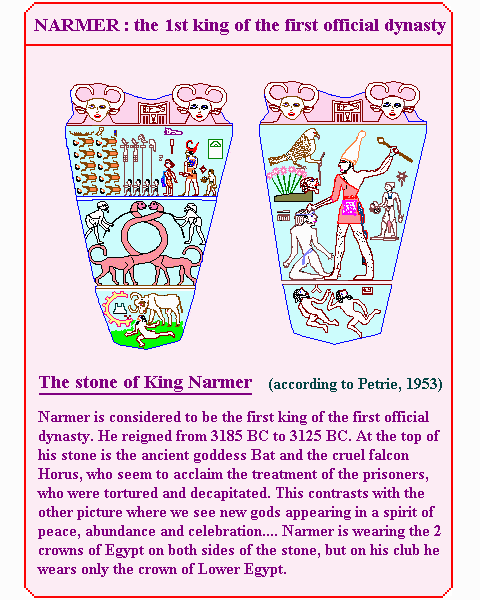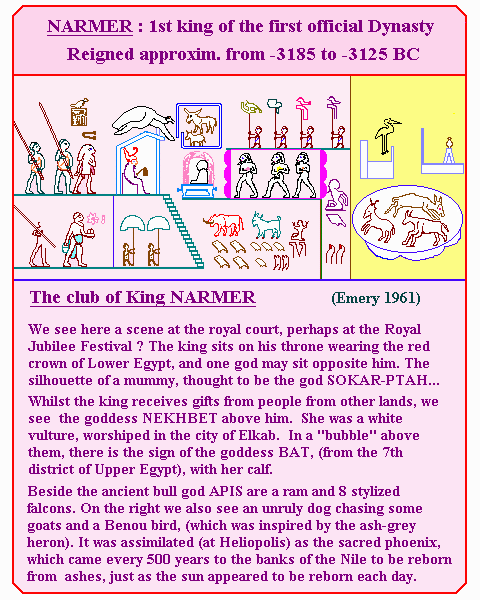
Egypt under the First DYNASTY
: |
Names of the 8 Pharaohs of the first DYNASTY |
||
Period from -3185 to -2925 BC |
||
Ref. Stone of Palermo |
Ref Manethon |
approx. length of reign |
| 1. Narmer | Menes | -3 185 to -3 125 BC |
| 2. Aha | Athotis | -3 125 to -3 100 BC |
| 3. Horus Djer | Kenkenes | -3 100 to -3 045 BC |
| 4. Ouadji-Djet | Ouenephes | -3 045 to -3 035 BC |
| 5. Horus Den (Oudimou) | Ousaphais | -3 035 to -2 980 BC |
| 6. Adjub | Miebis | -2 980 to -2 970 BC |
| 7. Horus Semerkhet | Semenpes | -2 970 to -2 960 BC |
| 8. Ka (Qaa) | Oubianthes | -2 960 to -2 925 BC |
Towards 3 150 BC, NARMER, the King of Upper Egypt went to war with the king of Lower Egypt and won. He annexed the Kingdom of the Delta, and took the red crown of his defeated adversary his authority directly from the Pharaoh.
Narmer found the city of Memphis and to better protect it, he surrounded it with an enormous WHITE WALL. The work on this huge undertaking lasted for several reigns of his successors. Narmer divided the kingdom of the Delta of the Nile into 16 Provinces, and he added to this the 22 districts or Provinces of Upper Egypt. Every district was administrated by a governor who took his authority directly from the Pharaoh.
The rock carving of King NARMER (Copied by Petrie 1953)
These rock carvings are masterpieces, which on close study
give us very interesting information on his period :

I. On the first side (A) of the stone we see a victory in battle
King Narmer wears the white crown of Upper Egypt, and holding his enemy, the King of the North, by the hair, he threatens him with his club. Likewise, the sacred falcon Horus hits the bebon dog (this dog was assimilated with the god Set of the Delta). To the rear the scribe prepares to engrave on two tablets the exploits of Pharaoh.
II. The other side (B) shows the festivities after the battle
The victorious king parades the animal gods of the districts before the decapitated bodies of his defeated enemies.The queen follows, her head surrounded by a half circle (the symbol of the royal authority, with the shape of a stylized Uraeus). One notices that the queen is twice the size both of the other people. Some headless, defeated enemies are lying on the ground, and some are also being taken away by the boats of the dead. The king dominates by his size the whole of the parade, and wears on his head as a sign of his triumph his new crown of Lower Egypt, while holding on his arm the white mitre of Upper Egypt.
Even though king Narmer appears as a pitiless, authoritative conqueror, one already sees the first elements of primitive religion which will "evolve" in the course of the next two dynasties until the arrival of Imhotep.
Beneath this, two warriors hold two bebon dogs of the defeated god Set. Note : the necks of the dogs are very long and thin, looking like two snakes, which were considered in the Delta as gods.
In the lower part of face B of the stone, the bull Apis threatens a defeated enemy who is naked and afraid. He is confronted by the strength both of the animal and of a huge resplendent sun (encircling the facade of a temple identical to the one to Horus at Edfou).
Second object of great interest : the club of King NARMER (Emery 1961)

In the first third to the left of the picture one sees two warriors, armed with spears, following the queen, who is walking towards the Pharaoh.
Narmer, wearing the red crown of Lower Egypt, has in front of him the god SOKAR or PTAH (represented as a mummy). Narmer is seated in his processional dais, where he is visited by some bearded ambassadors with long hair, bringing gifts as a sign of allegiance.
Higher up on the tableau, one sees distinctly the goddess Nekhbet who spreads her white vulture's wings to protect the Pharaoh. A cow and her calf express the desire for fertility, while a procession of porters bring in the animal effigies of the various districts.
In the bottom of the picture, the famous bull APIS, worshipped since antiquity in the region of Memphis, and considered by the priests of Heliopolis as a creator god, comes to the foot of the stage to assure Pharaoh of an auspicious and opulent reign.
Finally some stylized falcons, some goats, a heron (or the ancient Benou bird) keep vigil above a great palace, while below, a large wild dog (a wolf ?) chases some domestic animals to satisfy his hunger.
The successors of King NARMER
AHA, the son of Narmer, led several victorious campaigns against the neighboring countries of Nubia and Libya, which earned him the nickname of "Aha - the fighting Pharaoh."
Having demonstrated his power over the surrounding nations, he decided to send ambassadors to Canaan and Byblos in Phoenicia (the Lebanon) to establish peace and commercial trade. To consolidate his reign over the kingdom of the North, Aha married Neithotep (the lady who symbolizes the goddess Neith, who brings peace and bountifulness).
AHA not only continued the Great White Wall begun by his predecessor, but he also built his great royal palace of Memphis, taking care to add close by an imposing fortress in order to guarantee the security of his house.
From this period, different sculptures of the deathdog : Khentyimenty - (the one that watched over the kingdom of the dead in the west...) This cult of the dog who guarded the dead was assimilated in the third dynasty as the god ANUBIS, a man with the head of dog, who presided over the rituals of embalming and later helped Isis to restore Osiris for his resurrection.
All these relics show that the thinking and religious beliefs were still very primitive. Human sacrifice was often practiced, according to the writing of the egyptologist Helck (1987,149), who claims that there were human sacrifices performed even before the royal palace! Superstition was rampant, and even the Pharaoh would not go anywhere without his Imyout, which was the skin of an animal hung on a hook - a fetish!
After having retrieved some of the swamps of Fayoum, founded the city of Crocodilopolis, built the first temple to the god Ptah, the king AHA died violently, according to some legends. The queen Neithotep became regent until their child was old enough to reign: the Pharaoh " DJER - Kenkenes." Note the strange similarity between the names Djer and of king Djoser of the 3rd dynasty.
o - o - o - o - o - o - o